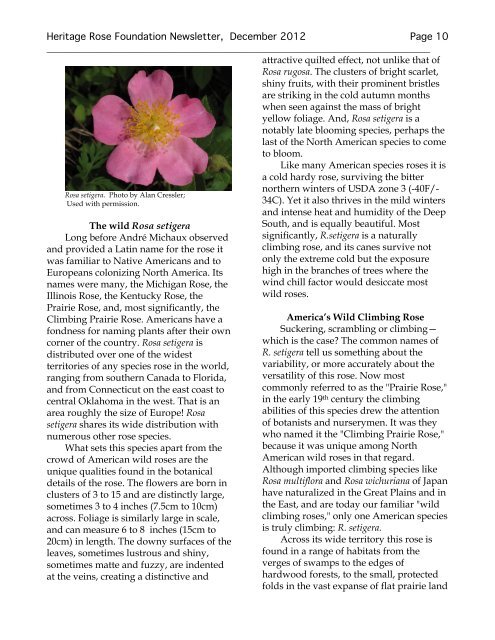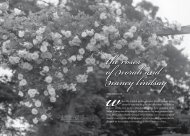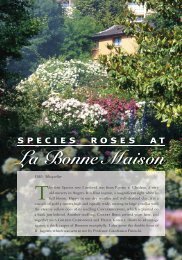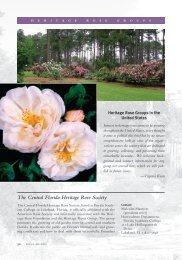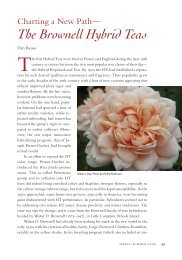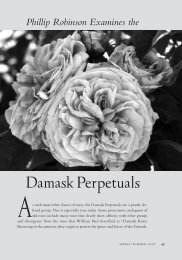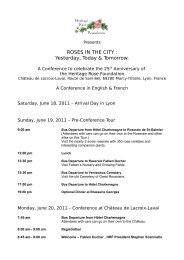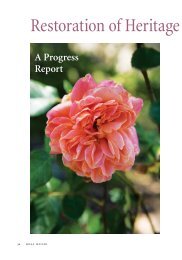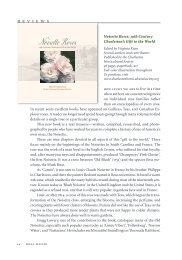Newsletter - Heritage Rose Foundation
Newsletter - Heritage Rose Foundation
Newsletter - Heritage Rose Foundation
Create successful ePaper yourself
Turn your PDF publications into a flip-book with our unique Google optimized e-Paper software.
<strong>Heritage</strong> <strong>Rose</strong> <strong>Foundation</strong> <strong>Newsletter</strong>, December 2012 Page 10<br />
_______________________________________________________________________________<br />
attractive quilted effect, not unlike that of<br />
Rosa rugosa. The clusters of bright scarlet,<br />
shiny fruits, with their prominent bristles<br />
are striking in the cold autumn months<br />
when seen against the mass of bright<br />
yellow foliage. And, Rosa setigera is a<br />
notably late blooming species, perhaps the<br />
last of the North American species to come<br />
to bloom.<br />
Like many American species roses it is<br />
a cold hardy rose, surviving the bitter<br />
northern winters of USDA zone 3 (-40F/-<br />
Rosa setigera. Photo by Alan Cressler;<br />
Used with permission.<br />
34C). Yet it also thrives in the mild winters<br />
and intense heat and humidity of the Deep<br />
South, and is equally beautiful. Most<br />
significantly, R.setigera is a naturally<br />
climbing rose, and its canes survive not<br />
only the extreme cold but the exposure<br />
high in the branches of trees where the<br />
wind chill factor would desiccate most<br />
wild roses.<br />
The wild Rosa setigera<br />
Long before André Michaux observed<br />
and provided a Latin name for the rose it<br />
was familiar to Native Americans and to<br />
Europeans colonizing North America. Its<br />
names were many, the Michigan <strong>Rose</strong>, the<br />
Illinois <strong>Rose</strong>, the Kentucky <strong>Rose</strong>, the<br />
Prairie <strong>Rose</strong>, and, most significantly, the<br />
Climbing Prairie <strong>Rose</strong>. Americans have a<br />
fondness for naming plants after their own<br />
corner of the country. Rosa setigera is<br />
distributed over one of the widest<br />
territories of any species rose in the world,<br />
ranging from southern Canada to Florida,<br />
and from Connecticut on the east coast to<br />
central Oklahoma in the west. That is an<br />
area roughly the size of Europe! Rosa<br />
setigera shares its wide distribution with<br />
numerous other rose species.<br />
What sets this species apart from the<br />
crowd of American wild roses are the<br />
unique qualities found in the botanical<br />
details of the rose. The flowers are born in<br />
clusters of 3 to 15 and are distinctly large,<br />
sometimes 3 to 4 inches (7.5cm to 10cm)<br />
across. Foliage is similarly large in scale,<br />
and can measure 6 to 8 inches (15cm to<br />
20cm) in length. The downy surfaces of the<br />
leaves, sometimes lustrous and shiny,<br />
sometimes matte and fuzzy, are indented<br />
at the veins, creating a distinctive and<br />
America’s Wild Climbing <strong>Rose</strong><br />
Suckering, scrambling or climbing—<br />
which is the case? The common names of<br />
R. setigera tell us something about the<br />
variability, or more accurately about the<br />
versatility of this rose. Now most<br />
commonly referred to as the "Prairie <strong>Rose</strong>,"<br />
in the early 19 th century the climbing<br />
abilities of this species drew the attention<br />
of botanists and nurserymen. It was they<br />
who named it the "Climbing Prairie <strong>Rose</strong>,"<br />
because it was unique among North<br />
American wild roses in that regard.<br />
Although imported climbing species like<br />
Rosa multiflora and Rosa wichuriana of Japan<br />
have naturalized in the Great Plains and in<br />
the East, and are today our familiar "wild<br />
climbing roses," only one American species<br />
is truly climbing: R. setigera.<br />
Across its wide territory this rose is<br />
found in a range of habitats from the<br />
verges of swamps to the edges of<br />
hardwood forests, to the small, protected<br />
folds in the vast expanse of flat prairie land


